Zui hao de shi guang / (Three Times) - Movie Review
 Zui hao de shi guang / (Three Times) 2005
Zui hao de shi guang / (Three Times) 2005“Rain and tears
both I shun
for in my heart there’ll never be a sun”
- Aphrodite’s Child
 One of the most difficult emotions to capture honestly on film is love. What? But what about all those romantic comedies, dramas, epics, etc? Yes, well, when was the last time you went to any film labeled “romantic” and genuinely felt that the two characters were in love? Besides those cowboys. Almost never, in our expert opinion. Which is why there is great reason to cheer with the U.S. debut of the international critic’s darling “Three Times” by Taiwanese auteur Hou Hsiao-hsien. Hsiao-hsien, a favorite of the Cannes Film Festival where most of his films seem to perennially be up for the Palme D’or, when they are not actually copping the grand honor returns with a movie that examines the courtship ritual surrounding two lovers. Or six. Depends on your point of view.
One of the most difficult emotions to capture honestly on film is love. What? But what about all those romantic comedies, dramas, epics, etc? Yes, well, when was the last time you went to any film labeled “romantic” and genuinely felt that the two characters were in love? Besides those cowboys. Almost never, in our expert opinion. Which is why there is great reason to cheer with the U.S. debut of the international critic’s darling “Three Times” by Taiwanese auteur Hou Hsiao-hsien. Hsiao-hsien, a favorite of the Cannes Film Festival where most of his films seem to perennially be up for the Palme D’or, when they are not actually copping the grand honor returns with a movie that examines the courtship ritual surrounding two lovers. Or six. Depends on your point of view. The trick up his crafty little sleeve is that he has imagined three separate couples throughout the past century and opted to cast the same two actors as the leads in each separate storyline. The film begins in 1966, with a stunning dance around love; continues backwards into 1911 with a look at a star crossed duo and finally ends up in the present day with a feisty young pair of lovers. The time traveling sets of lovers are portrayed flawlessly by Shu Qi and Chang Chen.
The trick up his crafty little sleeve is that he has imagined three separate couples throughout the past century and opted to cast the same two actors as the leads in each separate storyline. The film begins in 1966, with a stunning dance around love; continues backwards into 1911 with a look at a star crossed duo and finally ends up in the present day with a feisty young pair of lovers. The time traveling sets of lovers are portrayed flawlessly by Shu Qi and Chang Chen. “A Time for Love” is the title of the opening act set in and around a local billiards parlor within the industrial landscape of Kaohsiung City. We meet Chen, a young soldier who spends his free time shooting pool with his eye firmly on the young hostess in charge. When his favorite gal departs for a different billiards parlor, his lingering gaze falls upon her replacement, the gorgeous young May. (Seriously, May is played by the stupefyingly gorgeous Shu Qi! What a looker! And those outfits she wears! Tasteful yet kicky. Love!) Soon, they are circling each other in one of the most ravishing and tender depictions of young love we have ever seen depicted on the silver screen.
“A Time for Love” is the title of the opening act set in and around a local billiards parlor within the industrial landscape of Kaohsiung City. We meet Chen, a young soldier who spends his free time shooting pool with his eye firmly on the young hostess in charge. When his favorite gal departs for a different billiards parlor, his lingering gaze falls upon her replacement, the gorgeous young May. (Seriously, May is played by the stupefyingly gorgeous Shu Qi! What a looker! And those outfits she wears! Tasteful yet kicky. Love!) Soon, they are circling each other in one of the most ravishing and tender depictions of young love we have ever seen depicted on the silver screen. Hou Hsiao-hsien establishes a tone and pace for the first film that can best be described as that first blush of romance. The camera lingers, never calling undue attention to itself as it flows throughout the scenes. His color palette is filled with the bold patterns and rich colors of mid-60s design elements set against the urban grit of a crowded cityscape. This is not a film that dwells on action, complicated plots or intricate dialogue. It is a film that attempts to explore the emotions surrounding romantic love through its tonality, pacing, ravishing visuals, sound (particularly in its careful selection of music) and the chemistry between its talented young leads.
Hou Hsiao-hsien establishes a tone and pace for the first film that can best be described as that first blush of romance. The camera lingers, never calling undue attention to itself as it flows throughout the scenes. His color palette is filled with the bold patterns and rich colors of mid-60s design elements set against the urban grit of a crowded cityscape. This is not a film that dwells on action, complicated plots or intricate dialogue. It is a film that attempts to explore the emotions surrounding romantic love through its tonality, pacing, ravishing visuals, sound (particularly in its careful selection of music) and the chemistry between its talented young leads. When Chen and May exchange their first few looks, we feel it right down to our bones. As the edge closer and closer to each others hearts, we were held enraptured in their glow. The first part of the trilogy of films that comprises “Three Times” may be one of the most powerful depictions of love we have ever seen. It was pure bliss from playful start to wistful finish.
When Chen and May exchange their first few looks, we feel it right down to our bones. As the edge closer and closer to each others hearts, we were held enraptured in their glow. The first part of the trilogy of films that comprises “Three Times” may be one of the most powerful depictions of love we have ever seen. It was pure bliss from playful start to wistful finish. “A Time for Freedom”, the second act of the film set in 1911 during the Japanese occupation of Taiwan is the most stylistically daring of the pieces. Taking a cue from its timeframe and his apparent love for cinema, Hsiao-hsien opted to play the piece as a Silent Film! Cheeky devil. It tells the tale of a young courtesan whose friendship with a married diplomat turns to love over the course of their conversations. His sense of pride, respect and honor forbid him confusing his need to satisfy his lust with engendering love. Which is just what the young courtesan needs most from a seemingly caring man who has captured her heart completely. But, as is the case in their time and place they must never reveal their deepest emotions knowing full well it can never become a reality.
“A Time for Freedom”, the second act of the film set in 1911 during the Japanese occupation of Taiwan is the most stylistically daring of the pieces. Taking a cue from its timeframe and his apparent love for cinema, Hsiao-hsien opted to play the piece as a Silent Film! Cheeky devil. It tells the tale of a young courtesan whose friendship with a married diplomat turns to love over the course of their conversations. His sense of pride, respect and honor forbid him confusing his need to satisfy his lust with engendering love. Which is just what the young courtesan needs most from a seemingly caring man who has captured her heart completely. But, as is the case in their time and place they must never reveal their deepest emotions knowing full well it can never become a reality. And finally, “A Time for Youth” set in present day Taiwan – 2005. We find our time traveling actors portraying two outwardly brash and emotionally stifled young hipsters who careen through the streets of the city on a speeding motorcycle. Their romance, if you can call it that echoes their outwardly careless nature. Jing lives a freewheeling lifestyle and sexuality incorporating her emotionally clinging girlfriend and her bracingly cool boyfriend who vie for her affections. Their love affair – not quite doomed but certainly not flourishing is played against the cool color palette of a neon glow. They express more emotion via text message conversations than they do in person.
And finally, “A Time for Youth” set in present day Taiwan – 2005. We find our time traveling actors portraying two outwardly brash and emotionally stifled young hipsters who careen through the streets of the city on a speeding motorcycle. Their romance, if you can call it that echoes their outwardly careless nature. Jing lives a freewheeling lifestyle and sexuality incorporating her emotionally clinging girlfriend and her bracingly cool boyfriend who vie for her affections. Their love affair – not quite doomed but certainly not flourishing is played against the cool color palette of a neon glow. They express more emotion via text message conversations than they do in person. While this film dances around the various aspects of love, it absolutely blindsided us with its complex range of emotions. The tender fear of intimacy that the young couple feels in 1966 as they begin to feel each other out is the starting point for the second act. When we meet the Silent Lovers of 1911, we discover two people who are too intelligent and mature to play any adolescent charades as they explore their relationship. When the time tossed duo has reached the present day, any sense of flushed timidity or respectful adoration has been replaced by tactless mind games and animal urges.
While this film dances around the various aspects of love, it absolutely blindsided us with its complex range of emotions. The tender fear of intimacy that the young couple feels in 1966 as they begin to feel each other out is the starting point for the second act. When we meet the Silent Lovers of 1911, we discover two people who are too intelligent and mature to play any adolescent charades as they explore their relationship. When the time tossed duo has reached the present day, any sense of flushed timidity or respectful adoration has been replaced by tactless mind games and animal urges. While a case may be made that the director is implying we have lost our sense of romance over the years and replaced it with pure lust, we think the real glory of this wonderful movie is how Hsiao-hsien manages to incorporate all the emotional ranges within each storyline. The young soldier in Act One is hardly noble in his fluid ability to replace one lovely young lass for another.
While a case may be made that the director is implying we have lost our sense of romance over the years and replaced it with pure lust, we think the real glory of this wonderful movie is how Hsiao-hsien manages to incorporate all the emotional ranges within each storyline. The young soldier in Act One is hardly noble in his fluid ability to replace one lovely young lass for another.  The courtesan and client in Act Two understand too well the societal framework for their relationship and dare not cross its boundaries. The two hipsters in Act Three may seem shallow in their inability to communicate on any level besides sexual if it weren’t for the genuine emotion they obviously battle to express and suppress.
The courtesan and client in Act Two understand too well the societal framework for their relationship and dare not cross its boundaries. The two hipsters in Act Three may seem shallow in their inability to communicate on any level besides sexual if it weren’t for the genuine emotion they obviously battle to express and suppress. What Hsiao-hsien has done is to paint three involving, visually intoxicating and emotionally honest portrayals of the many facets of love. We have never felt so in love with the possibility of young love and the pure spirit of moviemaking in quite awhile. If the film seems to linger too long in places – each act is roughly forty minutes long – it more than compensates by the power of its storytelling. Some of the images are so gorgeous and so heartfelt in their connectedness to the central characters emotions; we can forgive the slight excess. We would gladly have sat through one more scenario all for the glory of bathing in the opening and closing shots that capture this beautiful films essence. One of the loveliest films about love we have ever seen. Bless you all!
What Hsiao-hsien has done is to paint three involving, visually intoxicating and emotionally honest portrayals of the many facets of love. We have never felt so in love with the possibility of young love and the pure spirit of moviemaking in quite awhile. If the film seems to linger too long in places – each act is roughly forty minutes long – it more than compensates by the power of its storytelling. Some of the images are so gorgeous and so heartfelt in their connectedness to the central characters emotions; we can forgive the slight excess. We would gladly have sat through one more scenario all for the glory of bathing in the opening and closing shots that capture this beautiful films essence. One of the loveliest films about love we have ever seen. Bless you all!Directed by Hou Hsiao Hsien
Written by Chu T’ien-wen
Starring
Shu Qi as May / Courtesan / Jing
Chang Chen as Chen / Mr. Chang / Zhen
Mei-fang as Old Woman
Liao Su-Jen as Madam / Jing’s mother
Di-Mei as May’s mother / Madam
Chen Shih-shan as Haruko / Ah Mei
Lee Pei-hsuan as Hostess / Micky
Cinematography by Mark Lee Ping-Bin
Film Editing by Liao Ching-Song
Costume Design by Wang Kian-Yi (Stylist 1911), Tsai Yi-Tsen (1966), Wu Mei-Hui (2005) and Tan Hsin-Wem
Production Design by Hwamg Wem-Ying
Art Direction by Wang Chih-Liang
Labels: Movie Review

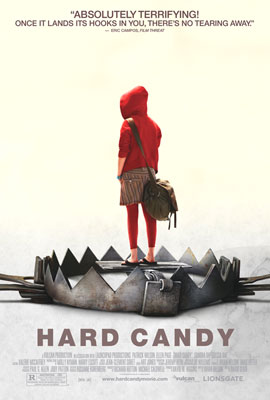 “Hard Candy” details an encounter between a handsome charming thirtysomething year old single man and a spunky fourteen year old girl. Now if this were set in
“Hard Candy” details an encounter between a handsome charming thirtysomething year old single man and a spunky fourteen year old girl. Now if this were set in 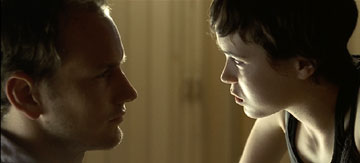 The script is by Brian Nelson and the direction is by David Slade. We think Mr. Slade should be commended for attempting his best to make the experience a cinematic one, filling the screen with saturated color, carefully arranged set ups and dizzying camerawork. Mr. Nelson needs to attend a writers seminar post haste or get out of the house more. While the set up might have been interesting for a half hour NC-17 episode of “
The script is by Brian Nelson and the direction is by David Slade. We think Mr. Slade should be commended for attempting his best to make the experience a cinematic one, filling the screen with saturated color, carefully arranged set ups and dizzying camerawork. Mr. Nelson needs to attend a writers seminar post haste or get out of the house more. While the set up might have been interesting for a half hour NC-17 episode of “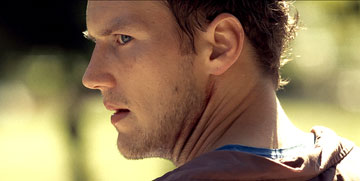 Patrick Wilson is the Broadway heartthrob who racked up two
Patrick Wilson is the Broadway heartthrob who racked up two 
 And the very talented
And the very talented 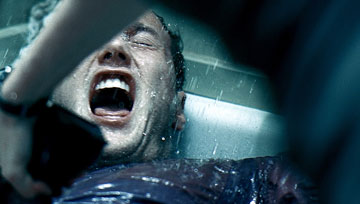 With the strong performance by Patrick Wilson as Jeff, and the lesser but still impressive turn by Ellen Page as Hayley we had to wonder where the film went wrong. And to this end, we must fall back on our dislike of the scenario and the all too technical focus from the director.
With the strong performance by Patrick Wilson as Jeff, and the lesser but still impressive turn by Ellen Page as Hayley we had to wonder where the film went wrong. And to this end, we must fall back on our dislike of the scenario and the all too technical focus from the director.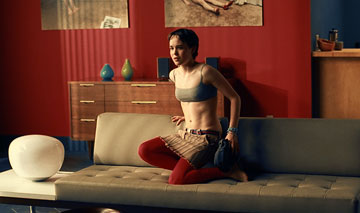 Director David Slade’s visual stylings clearly reflect his
Director David Slade’s visual stylings clearly reflect his 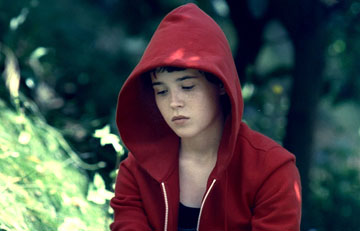 As for the screenplay, we understand full well that the nature of online dating and chat rooms have opened up a veritable wolf’s den of pervs out there upon an unsuspecting populace. But if we are to believe some of the more melodramatic moments of the film, it would have been more powerful and commanding to restrict the unbelievable subplots. Although we did enjoy some of the spicy dialogue which landed some well aimed barbs at the current fad of online dating. And whoever is to blame for the horrifically bad visual metaphor of the “Little Red Riding Hood” moment towards the end, should be taken to a lonely shack in the sticks and beaten to death.
As for the screenplay, we understand full well that the nature of online dating and chat rooms have opened up a veritable wolf’s den of pervs out there upon an unsuspecting populace. But if we are to believe some of the more melodramatic moments of the film, it would have been more powerful and commanding to restrict the unbelievable subplots. Although we did enjoy some of the spicy dialogue which landed some well aimed barbs at the current fad of online dating. And whoever is to blame for the horrifically bad visual metaphor of the “Little Red Riding Hood” moment towards the end, should be taken to a lonely shack in the sticks and beaten to death.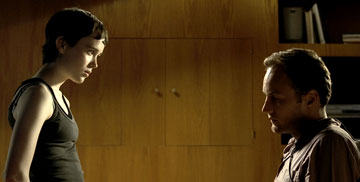 There do remain some powerful moments in the film, but we cannot help but think they stem from a very basic human fear of evisceration rather than strong writing and directing. Who would not wince when threatened with a scalpel wielding fourteen year old lecturing you on your sexual proclivities while holding your balls in a vice. And while the notion of a seemingly defenseless young girl being able to physically and mentally turn the tables on a potential predator may seem noble or even heroic in a better screenplay – the underlying manipulations and schemes of Hayley’s are far too contrived to be believed. She sadly emerges to be less and less of a vigilante / heroine and more and more of a “B Horror Movie” mustache twirling ogre who is one “Bwa-ha-ha” knife waving moment away from camp.
There do remain some powerful moments in the film, but we cannot help but think they stem from a very basic human fear of evisceration rather than strong writing and directing. Who would not wince when threatened with a scalpel wielding fourteen year old lecturing you on your sexual proclivities while holding your balls in a vice. And while the notion of a seemingly defenseless young girl being able to physically and mentally turn the tables on a potential predator may seem noble or even heroic in a better screenplay – the underlying manipulations and schemes of Hayley’s are far too contrived to be believed. She sadly emerges to be less and less of a vigilante / heroine and more and more of a “B Horror Movie” mustache twirling ogre who is one “Bwa-ha-ha” knife waving moment away from camp.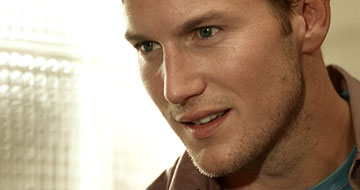 And so kids, we must leave you with this morality tale – since clearly this film will not. Patrick Wilson, good. Online sexual predators, bad. Bless you all!
And so kids, we must leave you with this morality tale – since clearly this film will not. Patrick Wilson, good. Online sexual predators, bad. Bless you all!
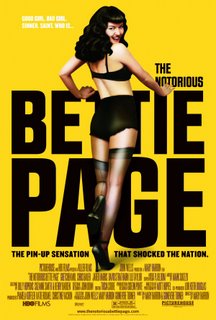 Turns out that Miss Mol is a talented actress, perhaps not the next
Turns out that Miss Mol is a talented actress, perhaps not the next 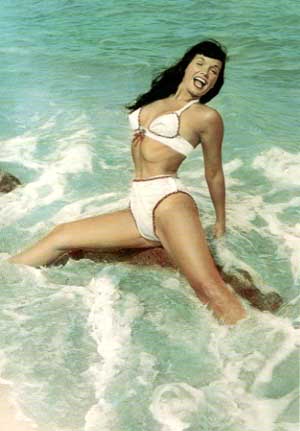 Back to our biopic. As many a perv will tell you,
Back to our biopic. As many a perv will tell you,  As the 1950s progressed, the dawn of the “
As the 1950s progressed, the dawn of the “ Director
Director 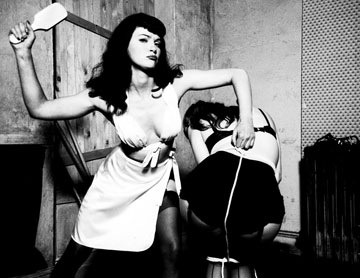 While the real Bettie Page has taken on the status of mythology over the years, we were surprised how textbook biopic fodder her real life was. Part of a large
While the real Bettie Page has taken on the status of mythology over the years, we were surprised how textbook biopic fodder her real life was. Part of a large 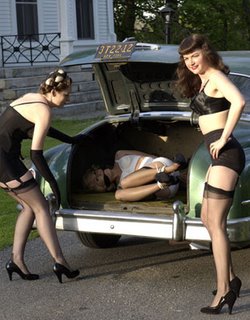 What remains curious about her tale is the brevity of her contemporary fame and the gradual manipulation of her image to incorporate such lofty ideals as
What remains curious about her tale is the brevity of her contemporary fame and the gradual manipulation of her image to incorporate such lofty ideals as 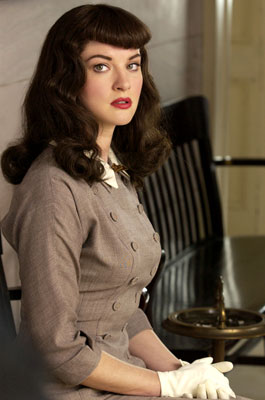 In many ways, Gretchen Mol is the perfect choice to eschew the lead role. She too has been saddled with a notorious past and dreams of stardom. Her transmogrification into the mid-century masturbatory fantasy is complete. Not the least for her ability to incorporate a free wheeling sense of sexuality while maintaining a believable innocence. We never question her naiveté, for the director and screenwriter tackle it head on. Bettie may be ignorant of some less than worldly views, but she is perfectly game to learn and master the ability to brandish a whip and slap on the thigh-high-lace-up-boots when necessary. (Pay attention girls, this could come in handy in life. Trust us.)
In many ways, Gretchen Mol is the perfect choice to eschew the lead role. She too has been saddled with a notorious past and dreams of stardom. Her transmogrification into the mid-century masturbatory fantasy is complete. Not the least for her ability to incorporate a free wheeling sense of sexuality while maintaining a believable innocence. We never question her naiveté, for the director and screenwriter tackle it head on. Bettie may be ignorant of some less than worldly views, but she is perfectly game to learn and master the ability to brandish a whip and slap on the thigh-high-lace-up-boots when necessary. (Pay attention girls, this could come in handy in life. Trust us.)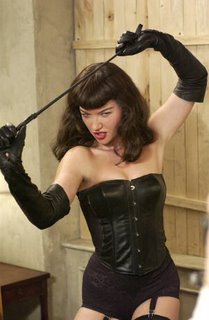 When the world around her begins to act in shock and dismay to Bettie’s daily craft, she is mystified at the uproar. As far as she’s concerned they were merely harmless pics made for
When the world around her begins to act in shock and dismay to Bettie’s daily craft, she is mystified at the uproar. As far as she’s concerned they were merely harmless pics made for 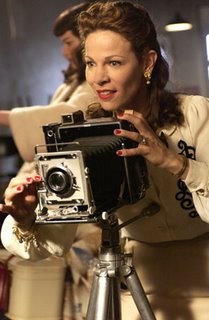 Supported by a cornucopia of acting talent from film, television and the Great White Way – notably indy fave
Supported by a cornucopia of acting talent from film, television and the Great White Way – notably indy fave  Let’s just be happy that Gretchen is up to the job handed to her in such a succinct and well made package by Mary Harron and Guinevere Turner. While this may not be a
Let’s just be happy that Gretchen is up to the job handed to her in such a succinct and well made package by Mary Harron and Guinevere Turner. While this may not be a 
 From the opening scene of “
From the opening scene of “ “Brick” exists in a cinematic wonderland affectionately dubbed “Film Noir” by those nutty
“Brick” exists in a cinematic wonderland affectionately dubbed “Film Noir” by those nutty  At its dark core, “Film Noir” is as escapist as one can get in Film. The characters are stock creatures that exist in the morally corrupt world of booze, cigarettes, drugs, murder, mayhem and everything else that makes life worth living. We don’t go to see “Films Noirs” to get a slice-of-life moviegoing experience. We go to be entertained and drawn into a netherworld of low-life types who know how to handle a gun, slap a broad and pour a stiff one all in the same frame.
At its dark core, “Film Noir” is as escapist as one can get in Film. The characters are stock creatures that exist in the morally corrupt world of booze, cigarettes, drugs, murder, mayhem and everything else that makes life worth living. We don’t go to see “Films Noirs” to get a slice-of-life moviegoing experience. We go to be entertained and drawn into a netherworld of low-life types who know how to handle a gun, slap a broad and pour a stiff one all in the same frame. As Brendan Frye, the anti-hero protagonist,
As Brendan Frye, the anti-hero protagonist,  “Brick” made a splash at the
“Brick” made a splash at the  But if language were all that Mr. Johnson brings to the table, we would have been better off reading the screenplay. What we enjoyed most was his visual flair and ability to depict a dark and sterile environment that frames the action and still manages to allude to the present day hormonally challenged setting. The high school is series of empty concrete vistas, the crime lord’s lair a refurbished basement office devoid of clutter and hilariously indicative of his youthful status with his doting mother doling out cookies and orange juice to his coterie of thugs. By updating the 1940s dialogue and character types into the present day youthful terrain, Mr. Johnson never falters in finding a cinematic balancing point.
But if language were all that Mr. Johnson brings to the table, we would have been better off reading the screenplay. What we enjoyed most was his visual flair and ability to depict a dark and sterile environment that frames the action and still manages to allude to the present day hormonally challenged setting. The high school is series of empty concrete vistas, the crime lord’s lair a refurbished basement office devoid of clutter and hilariously indicative of his youthful status with his doting mother doling out cookies and orange juice to his coterie of thugs. By updating the 1940s dialogue and character types into the present day youthful terrain, Mr. Johnson never falters in finding a cinematic balancing point.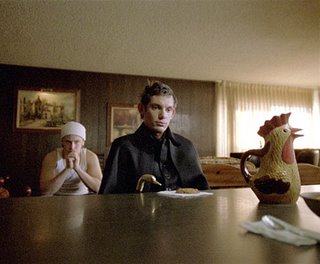 While the lead performance of Joseph Gordon-Levitt provides the solid center to the flick, he is ably abetted by several equally talented youngsters.
While the lead performance of Joseph Gordon-Levitt provides the solid center to the flick, he is ably abetted by several equally talented youngsters. 
 These three are the prime stand-outs amongst the actors. The supporting players while perfectly cast for their types register in varying degrees of acting skills.
These three are the prime stand-outs amongst the actors. The supporting players while perfectly cast for their types register in varying degrees of acting skills. 
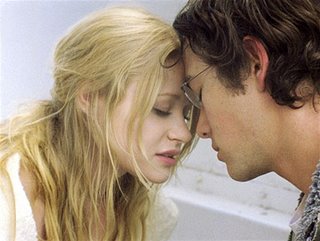

 And “
And “ Although when all is said and done, this film remains the brainchild of Rian Johnson. Under his assured eye, several key scenes smolder with visual delight. The baiting and pummeling between our hero and the main thug, who engage in a violent test of wills in an empty parking lot. The brilliantly filmed chase sequence which reverberates with heel to concrete rhythms and crescendos with a literally mind numbing gong. And the junior gangland climax at the kingpin’s lair that settles everyone’s hash in the most unpleasant manner.
Although when all is said and done, this film remains the brainchild of Rian Johnson. Under his assured eye, several key scenes smolder with visual delight. The baiting and pummeling between our hero and the main thug, who engage in a violent test of wills in an empty parking lot. The brilliantly filmed chase sequence which reverberates with heel to concrete rhythms and crescendos with a literally mind numbing gong. And the junior gangland climax at the kingpin’s lair that settles everyone’s hash in the most unpleasant manner. “Brick” manages to sell a high concept mix of classic and modern, and while it may stumble a bit and pick up a few bruises along the way it is ultimately a polished film that succeeds on its own merits. It’s labyrinthine language and masterful visuals are as intoxicating and satisfying a cinematic dessert as the aromatic mix of “coffee and pie, oh my!” Bless you all!
“Brick” manages to sell a high concept mix of classic and modern, and while it may stumble a bit and pick up a few bruises along the way it is ultimately a polished film that succeeds on its own merits. It’s labyrinthine language and masterful visuals are as intoxicating and satisfying a cinematic dessert as the aromatic mix of “coffee and pie, oh my!” Bless you all!
